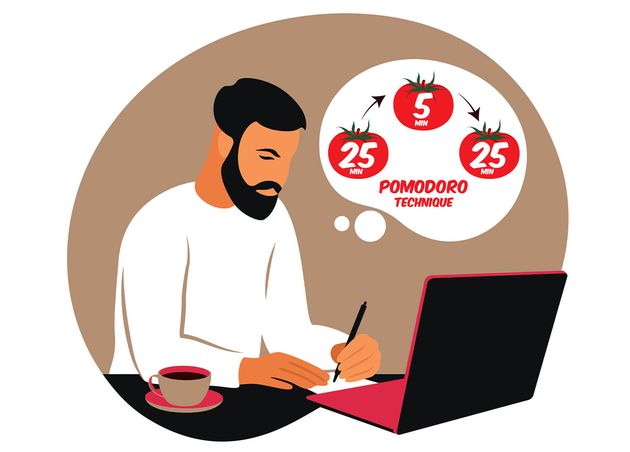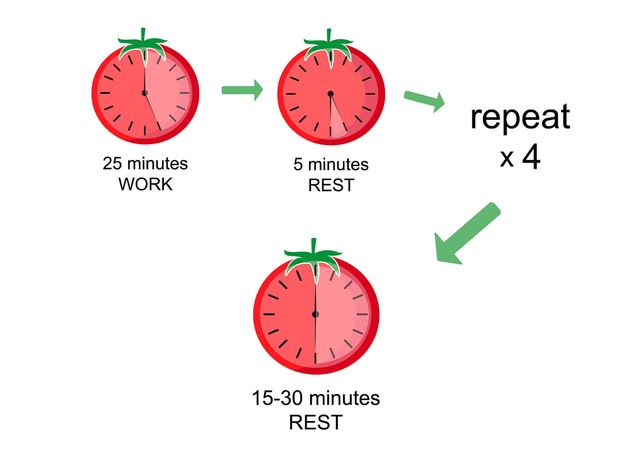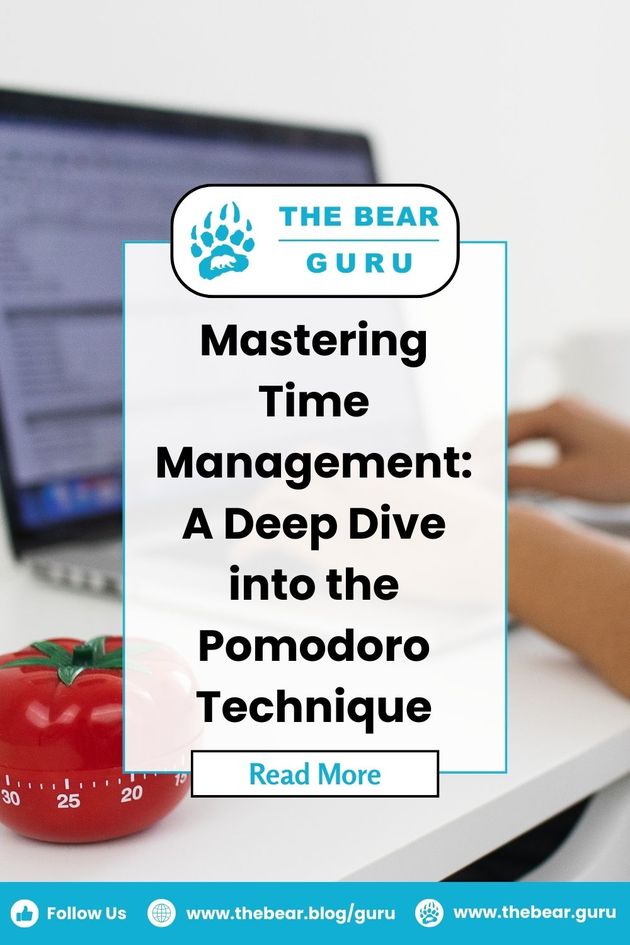Mastering Time Management: A Deep Dive into the Pomodoro Technique
Are you someone who struggles with productivity and finds ways to enhance it gradually? I comprehend the challenges of maintaining focus and efficiency in our daily lives. That's why I want to introduce you to the Pomodoro technique that has proven highly effective for many of my students, team members, and myself.
The Pomodoro Technique, created by Francesco Cirillo in the late 1980s, is a time management method designed to enhance productivity and focus. “Pomodoro” is an Italian word for tomato. The method is Cirillo’s tomato-shaped kitchen timer, which he used to time his work intervals. Cirilo says, “The Pomodoro method isn’t like most time management techniques. It’s not approximately squeezing as many responsibilities as feasible into a day. It's about taking the time to do things right and giving yourself the space to breathe."
The Pomodoro approach is straightforward.
- During the day, you allocate your time in short increments for each task and take breaks as needed.
- The Pomodoro Technique suggests taking a 5-minute break after each 25-minute work session, promoting a structured approach to managing time and maintaining focus.
- After completing four "Pomodoro" work sessions, which consist of 100 minutes of focused work time and 15-minute short breaks, you are advised to take a longer break of 15 to 30 minutes.
- After finishing a Pomodoro, note your progress with an "x" and monitor how frequently you procrastinated or switched tasks during each 25-minute time block.
The core idea behind this method is that by breaking work into smaller, more manageable chunks, you can then enhance your focus and productivity while avoiding burnout. This encapsulates the essence of the Pomodoro technique, emphasizing working smarter, not harder.
In this article, we'll explore more about what the Pomodoro approach entails, how it operates, and how it empowers you to maximize your time effectively, helping you achieve your goals.
🏆 Business Fact!
Organizations can utilize the Pomodoro technique to boost employee efficiency and eliminate distractions.
How to Use the Pomodoro Technique Effectively?
If distractions disrupt your workday, you frequently exceed your optimal productivity point, and you are confronted with numerous time-consuming tasks such as learning, brainstorming, or writing, the Pomodoro approach is the solution to enhance your productivity.
To use the Pomodoro method effectively, comply with these steps:
#1 Have a Clear Plan
You should plan your sessions or Pomodoros before commencing your work. Create a to-do list and monitor how many Pomodoros each task will necessitate. Any task requiring more than 5 Pomodoros should be divided into more minor responsibilities to stay on top of things. Smaller tasks, which include calling a colleague or sending an e-mail, can also be consolidated into a single Pomodoro.
If your workday extends to 8 hours or more, you should restrict yourself to no more than sixteen Pomodoros daily. In such cases, remember to postpone less critical tasks. For example, I begin each day by creating a to-do list of all the most important tasks that must be completed. This may involve strategy development, business performance review, and brainstorming for content direction. Maintaining a clear plan of what I need to address for the day aids me in staying focused.
#2 Use a Timer
You'll need an app or a timer for the Pomodoro technique. The timer on your phone is already a fantastic tool, and I also use it. Time yourself for these steps:
- Pick Your Tasks for the Day
- Select a task that needs improvement or a project that needs improvement.
- Ensure Your Timer is Set to 25 Minutes
- You should organize your working hours into 25-minute increments and adhere to the planned schedule.
- Work Until the Timer Goes Off
- Live focused and keep operating until you're notified.
- Take Breaks While Wanted
- Even if you’ve reached a country of glide, experience your smash while it comes.
- Working nonstop without taking quick breaks can cause pressure, harmful concentration, fatigue, and burnout.
I generally use the Pomodoro technique for my brainstorming classes. Set a timer for 25 minutes and work on it until it stops. I take a 5-minute break after each 25-minute session to clear my thoughts. This allows me to approach the task with a fresh and more creative perspective. Moreover, you could also try these apps:
- Focus Booster
- This is an excellent app to help you track how much time you've spent on a task.
- It allows you to time your sessions and adjust the duration of the session as needed.
- Rescue Time
- Rescue Time is one of the most famous time-monitoring apps to help you block distractions, track time, and generate reports about how your time is spent.
- Pomodoro Tracker
- This simple tracker lets you enter the tasks you want to work on throughout the day, time your sessions, and monitor your progress.
🏆 Business Trivia!
The technique has won recognition beyond private productivity. It is an expert improvement device to enhance talents and gain group knowledge.
#3 Plan for Overflow Pomodoro
A workday of eight hours is suitable with sixteen Pomodoros. But, creating a buffer of two to four overflow Pomodoros is vital. These Pomodoros should be used for tasks that take longer than expected or during workday emergencies.
If everything proceeds as intended, you can utilize the additional Pomodoros to address high-priority, often postponed tasks. It's always better to take additional Pomodoros over an extended period than to stretch yourself too thin and feel overwhelmed.
When a task requires more than four Pomodoro sessions (100 minutes), I add additional Pomodoros to finalize it. For instance, planning a new course or product might take 6 Pomodoros; I could also assign 2 Pomodoros to ensure the project's timely completion.
#4 Review and Adjust Your Pomodoro
Some tasks may require working for extended periods to complete them. For instance, writing, coding, and composing demand a state of flow to produce quality results, and 25 minutes might not be sufficient. Therefore, extending your work sessions with breaks can be a better option.
According to a desk time study, a 52-minute session with a 17-minute break is considered the ideal balance for productivity. Alternatively, some individuals may prefer a 90-minute session followed by a 20 to 30-minute break. If you feel fatigued or encounter mental resistance, contemplate reducing your sessions to fifteen or even 10 minutes. Adjust the durations based on your energy level, the nature of the work, and the quantity of tasks that require completion.
I review my completed tasks at the end of each week and adjust my Pomodoro sessions for the following week. For instance, I used to allocate 2 Pomodoros to review the website's technical performance; however, I consistently found that it took fewer Pomodoros, so I reduced it to 1 Pomodoro. You can focus more effectively, increase productivity, and reduce distractions by breaking down your work into manageable intervals.
Here are a few examples of how you can apply the Pomodoro approach in your everyday life:
- Writing
- When confronted with a writing assignment, such as an essay or work challenge, employ the Pomodoro technique to enhance your focus and productivity.
- Begin by setting a timer for 25 minutes, commonly known as a "pomodoro." Throughout this period, commit yourself wholly to writing, eliminating potential distractions.
- Once the 25 minutes elapse, take a short break of approximately 5 minutes. After completing four Pomodoros, indulge in an extended recharge break of 15-30 minutes.
- As emphasized in a Todoist article, this technique fosters sustained concentration and enables more efficient completion of writing tasks.
- Observe
- Are you gearing up for a substantial exam? The Pomodoro approach can be a valuable companion for your study sessions. Identify a subject or topic you must delve into and set your timer for 25 minutes.
- Immerse yourself in focused studying during this Pomodoro, and when the timer rings, take a brief 5-minute break.
- This approach, supported by Lucid Chart’s insights, enhances retention and keeps you engaged.
- Remember that consistently applying this approach can improve comprehension and increase study efficiency.
- Cleaning
- Even tasks like cleaning can benefit from the structured approach of the Pomodoro method. To tackle cleaning chores, set a 25-minute timer and focus exclusively on cleaning during that period.
- This strategy helps maintain focus and prevents distractions, enabling you to accomplish the task more efficiently.
- As mentioned on TechTarget, this technique breaks down tasks into manageable intervals, making them less overwhelming and more achievable.
The Pomodoro method is a potent productivity tool that enhances focus and productivity while reducing stress levels. You can sustain your energy levels and concentration for extended periods by breaking work into manageable intervals and taking regular breaks.
Although the Pomodoro technique has drawbacks, such as its rigid structure and the requirement to reset the timer regularly, these challenges can be addressed by evaluating its appropriateness for your specific situation and experimenting with different approaches. Incorporating the Pomodoro method into your daily routine allows you to become more efficient and achieve remarkable results in less time.
Recommended for you
Maintaining Aquatic Balance: Understanding the Temperature-Dissolved Oxygen Relationship
Riley Sinclair (Digital Aqua Bear)
1 Day in Thailand: How Much Money Do I Need?
Dr. Theodore (Professor Bear)
Hungry Nerd: Appetizing Steak and Pasta in Bangkok
Tle (Hungry Bear)
Wellness in Thailand: Top Retreats for Rejuvenation and Relaxation
Dr. Theodore (Professor Bear)
Top 10 Best Places to Learn Thai Cooking in Thailand
Rowan (Guinness Bear)






















